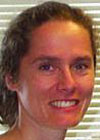 |
|
|
| Author |
Message |
Amy_Clapp

Joined: 23 Mar 2004
Posts: 84

|
 Posted:
Mon Jun 07, 2004 5:07 pm Posted:
Mon Jun 07, 2004 5:07 pm |
  |
June 7, 2004
Well, we had a beautiful day here in Zhigansk. The temperatures must have reached 60°F and it was as sunny as can be. It has been very strange to me how variable the weather is. In Vermont, we like to say if you don’t like the weather wait five minutes. But the changes in weather in Vermont are nothing compared to this. For example, it would not surprise me at all if tonight or tomorrow morning it snows. A few days ago, I wrote about wearing a short sleeve shirt on a hike, and that night when I was sending my journals, it did start snowing—crazy. But, at any rate, it was beautiful today.
We had another successful day out on the boat today. We got on the boat at noon after doing our regular shore sampling. The water level has gone down substantially—check out the water level PowerPoint!! It is amazing to all of us that one week ago the river was clogged with ice—you would never be able to guess that by looking at the river today!
http://archive.arcus.org/TREC/lena_river_shoreline.html
While we are on the boat sampling there is a five page procedure that we follow. This was written by the PARTNERS scientists before they started doing the samples and has been modified several times to accommodate for the reality of the rivers and sampling situations. I know that my students hate writing procedures for their science experiments (right, Salisbury students?), but guess what? They are really important. It is extremely important in this science experiment, since there are so many people and locations involved that everyone follows the same procedure. They even have the procedures written in two languages, English and Russian.
The part of the procedure that I found the most interesting is the information at the end. It reads “1. Always get samples. Even if everything goes wrong (D-96 lost, churn lost, whatever), figure out a way to get samples. Even collect samples from the shore if necessary.” I like this part because it shows that things don’t always work the way they are supposed to (even though they did for us). It also states how important it is to be a problem solver, to not just give up when things don’t go the way they are supposed to. Again, I know that my students hate it when a problem occurs and my response to “What should I do?” is “Figure something out.” But in reality that is what people, even scientists working in the Arctic, have to do.
The second piece of the procedure at the end says “2. If problems occur (and sometimes they will), make note of them on the Field Data Sheet. This information may be important for interpreting unusual results.” I know that Salisbury students hate it how I make them write everything down as they are doing science experiments. However, the leading scientists working on global climate change have to do just that—write everything down because even they can’t always remember everything that happened during an experiment.
So here are some pictures that show the procedure that is followed while collecting samples on the boat:
Rinse the churn with surface water before starting to sample.

Rinse all bottles three times with river water before filling.
When sampling and processing, wear latex gloves (in all the pictures of people handling bottles of the D-96, they should have gloves on).
The procedure with the D-96 is to:
1. Take the tray out.

2. Attach the Teflon bag using Velcro strap

3. Drop it (carefully) to the bottom of the river and bring it up.

4. Remove the tray with the filled up bag.

5. Fill sample bottles and/or dump it in the churn.

Here is a photo of the D-96 with sample:

So, the science end of things is starting to wind down here. We will do our last sampling from the shore tomorrow and then start getting the samples all ready to travel with us back to Moscow.
Oh yeah, we also had a fun game of basketball and volleyball last evening against some teachers and high school students from Zhigansk. The “Science Team” won the basketball game 40-46. For volleyball, we had mixed teams. It was really fun!

I have really changed my eating habits here—I’m eating fish right from the drying line now—I don’t even need them cooked (just kidding)!!!
 |
|
|
    |
 |
|
|
|
View next topic
View previous topic
You cannot post new topics in this forum
You cannot reply to topics in this forum
You cannot edit your posts in this forum
You cannot delete your posts in this forum
You cannot vote in polls in this forum
You cannot attach files in this forum
You can download files in this forum
|
Powered by phpBB 2.0.11
© 2001, 2002 phpBB Group :: FI Theme ::
All times are GMT
| |
